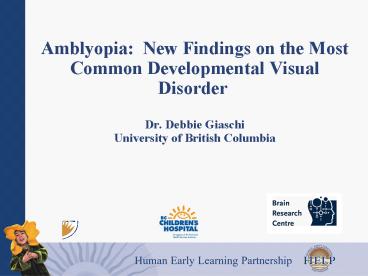Amblyopia: New Findings on the Most Common Developmental Visual - PowerPoint PPT Presentation
1 / 15
Title:
Amblyopia: New Findings on the Most Common Developmental Visual
Description:
treatment failures may occur because occlusion treats only some of the deficits ... Pokemon is in front. You press the 'yellow' button. Study 3: Occlusion ... – PowerPoint PPT presentation
Number of Views:246
Avg rating:3.0/5.0
Title: Amblyopia: New Findings on the Most Common Developmental Visual
1
- Amblyopia New Findings on the Most Common
Developmental Visual - Disorder
- Dr. Debbie Giaschi
- University of British Columbia
2
Amblyopia (lazy eye)
- impaired vision in one eye that cannot be
corrected with glasses - caused by deprivation of normal vision for a
prolonged period during development - usually strabismus (eye misalignment),
anisometropia (optical error difference) or both - affects 2.5 of general population
- often reversible through occlusion of good
(fellow) eye before 8 years of age - preschool vision screening important
- treatment failures may occur because occlusion
treats only some of the deficits
3
Classical form perception deficits in amblyopia
- recognition acuity
resolution acuity
Vernier acuity
visual distortions
4
Children with amblyopia have difficulty seeing
the flying bird, even in the fellow eye that has
normal visual acuity (Giaschi et al., 1992)
Surprising motion perception deficits in
amblyopia
5
The visual pathways
motion
posterior parietal
V5
V1
V1
inferior temporal
V4
form
6
Study 1 Functional MRI(with Cindy Ho)
Background
- Motion perception is hypothesized to involve both
low-level and high-level cortical mechanisms,
depending on the stimulus
Goal
- To establish the existence of low- and high-level
mechanisms for motion perception - To determine the cortical basis for the deficit
in amblyopia
Progress
- 4/8 controls and 6/8 children with amblyopia
tested
7
Study 1 Methods
confirmed
confirmed
8
Study 1 results (controls)
large vs. small dots
low vs. high density
- blue more activation with low-level stimuli
(small dots or high density) - red more activation with high-level stimuli
(large dots or low density)
9
Study 1 results (amblyopia)
No regions activated more by high-level motion
Less activation, relative to controls, by
low-level motion
blue more activation with low-level stimuli
(small dots or high density)
10
Study 2 Residual Binocular Vision (with Laurie
Wilcox)
Background
- Motion deficits greater in amblyopic children
with residual coarse stereopsis - Not measured clinically implications for
treatment success.
Goal
- To develop a child-friendly computer measure of
coarse stereopsis - To determine performance limits in children with
typical visual development - To determine if our new task reveals residual
binocular vision in amblyopia that is missed by
standard clinical tests
11
Study 2 Methods
Wilcox/Giaschi coarse stereo test
Clinical stereo test
Coarse stereopsis double vision perceive depth
Fine stereopsis single vision perceive depth
12
If the top Pokemon is in front
You press the blue button.
13
If the bottom Pokemon is in front
You press the yellow button.
14
Study 3 Occlusion therapy (with David Regan)
Background
- Amblyopia is treated by occluding the fellow eye
with a patch - Visual acuity may not improve improvement may be
temporary
Goal
- To determine the effect of occlusion therapy on
motion perception in children with amblyopia - To determine if coarse stereopsis predicts
treatment outcomes
15
The Team
- fMRI
- Cindy Ho
- Bosco Lee
- UBC High Field MRI Centre
- Jody Culham
- (U Western Ontario)
- Residual binocular vision
- Catherine Boden
- Jane Wang
- Laurie Wilcox (York U)
- Kevin Mackenzie (York U)
- Alexia Casalinuovo
- (York U)
Thank you

